|
“AND the whole earth
was of one language, and of one speech.”
(Genesis 11:1, KJV)
In the King James Bible the Hebrew
expression “ha-arets” (הָ\אָרֶץ) is often translated “the earth”. In many cases
the expression simply means “the land”. The verse above
(Genesis 11:1)
refers to an inhabited land, not the whole planet! In other words,
despite the way it comes across to modern readers, “the whole earth” doesn’t
mean the globe in this case. Take a second to consider the verse and you’ll
realize that it is the human occupants of a local land that is
referred to in Genesis 11:1. It was the land’s inhabitants that were “of one
language, and of one speech”.
Similarly, Helaman 3:8 in the Book of Mormon uses
the expression “the whole earth” in reference to a limited northern land
bounded in each of the cardinal direction by local bodies of water.
See also Ether 13:17,
25-26,
31.
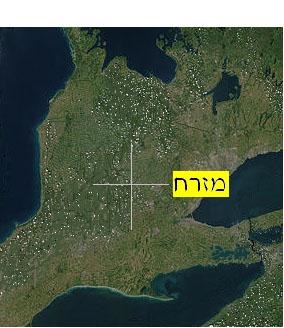
A “land northward” in the
region of scriptural “Cumorah”
(LDS Doctrine and Covenants 128:20),
bordered in each of the cardinal direction by inland seas
(Helaman 3:8)
The actual Hebrew meaning behind “earth” in Genesis 11:1
(KJV) is a key to understanding a strange sounding verse in the
chapter before:
“And unto Eber were born two sons: the name of one was
Peleg; for in his days was the earth divided; and his
brother's name was Joktan.”
(Genesis 10:25,
1 Chronicles 1:19 KJV)
Just as “earth” in Genesis 11:1 (KJV) means the
human inhabitants of the land, so “the earth divided” in Genesis 10:25 (KJV),
should be understood to mean the dividing of the human inhabitants of the
land. The “earth” in both these cases refers to the land’s
inhabitants – plain and simple.
(Genesis 41:36,
Joshua 23:14,
Mosiah 1:9)
There is no mention in the verse of
earthquakes or upheavals caused by dramatic decelerations of parted land
masses! The division in Peleg’s day was not about catastrophic
plate-tectonics. [1] It
was about the dividing of peoples “abroad upon the face of all the earth”.
(Genesis 11:9)
The name “Peleg” means “Split” or “Divide”. The verb
“palag” is translated “divide” in “divide their tongues…”
(Psalm 55:9) It’s
no coincidence that in both chapters 10 and 11 of Genesis, “Peleg” is
mentioned after “Babel”.
It’s true that long ago, the continents once joined to
form a single landmass; but the continents of the Eastern and Western
Hemispheres were already separated by vast oceans when the inhabitants of a
post-flood land divided in the days of Peleg!
(Genesis 11:8-16) [1]
Where was Nimrod’s “Shinar”?
Before the division of the people of the land, “they
journeyed from the east”, that is, from the mountains (hills) of Urartu, “the mountains of Ararat”,
where Noah’s ark came to rest.
(Genesis 8:4) “…they found a plain in
the land
of Shinar and they
dwelt there”.
(Genesis 11:2)
A straightforward interpretation of Genesis leads to the
conclusion that the original land
of Shinar (where the great tower
was built) was westward from the mountains of Ararat – not southward in Mesopotamia as posited by later traditions. In time people
migrated into Mesopotamia and elsewhere from Shinar.
The exact meaning of the ancient name “Shinar”
has been lost. Some want to construe it to mean “Two rivers” in reference to
the famous rivers of Mesopotamia. There are
of course numerous rivers and plains south of the Black Sea region; not just
the flood plains of the Tigris and Euphrates.
The assumption is that “shin” means “two”. But if “shin” means “two”, “Two
cities” is arguably a better interpretation of “Shin-ar” because of how the
“ar” is spelled in Hebrew. This begs a question: If “shin” really means
“two” why doesn’t the name “Shinar”
have a plural ending like “naharot” = “rivers”, or better yet: “arim” =
“cities”?
Since “Shinar” (שִׁנְעָר) is spelled with an “ayin” (ע), as is the Hebrew word for “city” (עִיר), could it be
that the name has more to do with a city than with rivers? Consider Genesis
11:4:
“And they said, Go to, let us build us a city and a
tower, whose top may reach unto heaven; and let us make us a
name, lest we be scattered abroad upon the face of the whole earth.”
(Genesis 11:4)
The name “Babel” (transliterated “Bavel”) is akin to the
Hebrew verb “balal” meaning “mingle”, “mix”, “confuse”, “confound”. Ancient
Hebrew scripture directly equates “Bavel” with “balal”. Apparently “Babel” meant “confusion” in an ancient tongue, for the city
was named “Babel;
because the LORD did there confound [confuse] the language of all the earth
[the land]”.
(Genesis 11:9)
“Babylon”, on the other hand, comes from
“bab-ilu” meaning “gate of god”. “Babylon”
has a different meaning than “Babel”.
It’s possible that “Bab-ilu” (Babylon) and
“Bavel” (Babel)
got confounded! “Bavel” became synonymous with Babylon
in Jewish writings; much as the Mesopotamian land called “Cush” later became confused with “Ethiopia”.
(Compare Genesis II. 13 in the Septuagint, with
Hebrew scripture) Shinar
became synonymous with Babylonia – the land between the Tigris and Euphrates rivers.
(Daniel 1:2) The impressive Mesopotamian
step-pyramids or ziggurats, reminiscent of the legendary tower, likely fed
the confusion.
An Apocryphal book of Jasher (sefer ha-Yasher, which is not the
more ancient work mentioned in
Joshua 10:13, and
2 Samuel 1:18) redacts the
straightforward geographic meaning of Genesis 11:2 in order to fit the later
tradition placing Shinar in Mesopotamia - not west of Ararat.
Compare:
“And it came to pass, as they journeyed from the
east [mountains of Ararat], that they found a plain in the land of Shinar;
and they dwelt there.”
(Genesis 11:2)
“And all the families assembled consisting of
about six hundred thousand men, and they went to seek an extensive piece of
ground to build the city and the tower, and they sought in the whole earth
and they found none like one valley at the east of the land of
Shinar, about two days’ walk, and they journeyed there and they dwelt
there.” (Apocryphal Jasher IX: 23)
Though Joseph Smith did not speak ill of the apocryphal
book of Jasher when he stated that it “has not been disproved as a bad
author...” (Editorial signed “ED.” by Joseph Smith,
“Persecution of the Prophets”, Times and Seasons, September 1, 1842,
Vol. 3, pg. 902), and though no apocryphal book of Jasher is included in the Septuagint’s selection of the Apocrypha (e.g. in the
Catholic Bible), LDS Doctrine and Covenants section 91
cautions those who read “the Apocrypha”:
“There are many things contained therein that are
not true, which are interpolations by the hands of men.”
This is good
admonition to keep in mind when reading apocryphal works in
general.
Placing Nimrod’s Shinar in Mesopotamia is quite possibly on a par
with Mormon traditions which erroneously place Book of Mormon lands
in Mesoamerica - among those wonderful ruins described in
John Lloyd Stephens’ 1841 bestseller. (Stephens, Incidents of Travel
in Central America, Chiapas and Yucatan, Vol. II, Ch. XXVI, “COMPARATIVE MODERN
DATE OF RUINS”, pp. 442-443)
It had been concluded in
American publications before the Book of Mormon was published
(1830), that the ruins in Mexico were relatively recent
works and not truly ancient.
(Ethan Smith, View of the Hebrews or the Tribes of Israel in America - Second Edition, 1825, pp. 146, 179, 184-193, 200)
This was the published view of Josiah Priest, Stephens and others, whose
works Joseph Smith was familiar with.
But
unlike Joseph Smith, who said he had read volumes I and II of Stephens’ bestseller
“with the greatest interest”, and had concluded that Stephens was “most
correct”
(The Personal Writing of Joseph Smith,,
compiled and edited by Dean C. Jessee, S.L.C., Deseret Book, 2002, pg. 533),
many Mormons paid little heed to the details – hence the
great Book of Mormon geography misadventure! (See Hampton Sides, THIS IS NOT THE PLACE)
Unsigned articles (possibly by John Taylor and Wilford Woodruff;
“Limited Geography and
the Book of Mormon: Historical Antecedents and Early Interpretations”, BYU
Maxwell Institute, 2004) appeared
in the Times and Seasons newspaper during Joseph Smith’s
public absence.
(LDS Doctrine and Covenants 127:1) These sensational
pieces featured extracts from Stephens’
work, and added that the “wonderful
ruins” of Central America “are among the
mighty works of the Nephites” – never mind the anachronisms. Ironically,
apostles John Taylor and Wilford Woodruff would later stand behind Orson
Pratt’s exaggerated views on Book of Mormon
geography (1879 edition of the
Book of Mormon footnotes), in
contradiction to the speculative things they had anonymously published years before on the
whereabouts of the ruins of “ZARAHEMLA”.
(Joseph Smith, Josiah Priest and the
Times and Seasons)
On the subject of Shinar west of the mountains of Ararat, here are some provocative articles to consider:
“TOWER OF BABEL FOUND?” by
Michael S. Sanders
“Tower Babel is ‘found’ near the Black
Sea”
by Jack Grimston
“Where in the World Is the Tower of Babel?”
by Anne
Habermehl
The Meaning of “Jared”
The patriarchal name “Jared” (יָרֶד),
more accurately pronounced “Yared” or “Yered”
(Genesis 5:15,
18;
see Hebrew scripture Bereshit 5:18), comes from
the verb “yarad” meaning come or go down, descend.
[2] Instances of wordplay on
the meaning of the ancient name appear in the abridged book of Ether – the
record of the “Jaredites” or “Yeredim”. In translation, the Gentile suffix
“ites” commonly substitutes for the Semitic “i” or “im”.
The name Ahyered (אֲחיֶרֶד)
can be interpreted to mean “my brother descends”. The construct of the name
is similar to that of biblical names containing the element “brother”. See
for example 1 Samuel 14:3 where “AhiYah” = “brother of the LORD”, and
“Ahituv” = “brother of goodness”. For the sake of a Gentile audience,
the name Ahyered (not the prophet’s only name) translates simply “the
brother of Jared”.
Tsafon = North
In telling the marvelous story of the journey of the
Yeredim from Shinar to the “the lake country of America”, the place where
the Prophet Joseph Smith said they arrived (See
Joseph Smith’s editorial (signed “ED.”) on a chapter from Priest’s
American Antiquities, Times and Seasons, June 15, 1842, Vol. 3,
pp. 818-820), its appropriate to begin with a verse from the biblical
account of the great tower:
“And the LORD came down (Heb. yered) to see
the city and the tower, which the children of men builded.”
(Genesis 11:5,
KJV) [2]
To appreciate the wordplay in the book of Ether (sefer
Eter) Keep in mind what “Jared” or “Yered” means.
From the great tower the Yeredim went “northward”,
descending into the valley called Nimrod, “being called after the mighty
hunter”.
(Ether 1:42;
2:1-4)
“And it came to pass
that when they had come down into the valley of Nimrod
the Lord came down and talked with the brother of Jared; and
he was in a cloud, and the brother of Jared saw him not.”
(Ether 2:4)
At the start, the LORD directed the Yeredim northward
(Ether 1:42) away from the city and the great tooth-like structure that
jutted up against heaven from the plain. “Shinar” in fact
could mean “Tooth of the
city”. “Shen” or “Shin” is the ancient Semitic word
for “tooth”. The land could have been named after the city and tower’s
construction were underway. The scripture does say “…let us build us a
city and a tower, whose top may reach unto heaven; and let us
make us a name …” in that order.
(Genesis 11:4;
see Hebrew scripture Bereshit 11:4)
Prior to the dispersion from the great tower, the people
of the land were united! They were “one” under an unrestrained government
which kept them busy and together!
(Genesis 11:6) But, unity for the sake of
unity, isn’t of itself commendable in the eyes of the Elohim.
(Genesis 11:7-8) Seeing in Shinar
a misguided consolidation of power, the LORD actually sought to bring about
division!
Scripture speaks against contention and says “if ye are
not one ye are not mine.”
(LDS Doctrine and Covenants 38:27)
But how can the promoting of unity by way of falsehoods, be pleasing him to whom Ahyered said “thou art a God of truth, and canst not lie”?
(Ether 3:12)
From the northern valley, the Yeredim were led by the
LORD into the wilderness, “where never man had been” – possibly an
uninhabited eastern coast of the Black Sea.
There they built, light navigable barges in which, with their flocks and
diverse cargo “they did cross many waters…”
(Ether 1:41,
2:1-2,
6)
In ancient Semitic tradition, the north, “tsafon”, was
associated with that which is “hidden” or “dark”, hence the
Black Sea quarter. [3]
After the flood, the north was regarded as a no man’s land – “that
quarter where there never had man been”.
(Ether 2:5) The scriptural use
of the term “quarter” suggests one of the four cardinal directions;
in this case, approximately the same general direction the Yeredim started
out in - the dark northern quarter. [3]
In footnote
[3]
see also Ethan Smith’s quotation and commentary on a reference from early Jewish literature (II Esdras
xiii.40) regarding a post-flood uninhabited northern land.
(The Tribes of Israel in America, a.k.a. A View of the Hebrews, 1825 Ed., pp. 74-75)
Mayim Rabim = Many Waters
“Mayim rabim” is translated “many waters” or “great
waters” in Hebrew scripture. The description “many waters” or “great waters”
is not the name of any particular body of water. Psalm 77:19-20 appears to
use “mayim rabim” in describing
“yam suf” the
“reed sea” that the LORD led Israel through.
Other scriptures seem to describe the Mediterranean
with its surf, storms and maritime traffic as “mayim rabim”.
(Psalm 29:3;
93:4;
107:23,
Isaiah 23:3,
Ezekiel 27:25-26). The great waters of Egypt are “mayim rabim”
(Ezekiel 32:13) as are
the rivers of Mesopotamia flowing into the Persian Gulf.
(Jeremiah 51:12-13,
Ezekiel 17:5;
19:9-10) Even local pools of Gibeon qualify as “mayim rabim”.
(Jeremiah 41:12) In a
vision of the American Promised Land, Nephi son of Lehi seems to describe
the Atlantic Ocean as “the many waters”.
(1 Nephi 13:10-12)
When the Book of Mormon prophet Lehi and his
company arrived at the southern coast of Arabia in the 6th
century BCE, they “beheld the sea”, the great Erythraean Sea or Indian
Ocean. They called the
Erythraean
Sea “Irreantum, which
being interpreted, is many waters.”
(1 Nephi 17:5)
The name “Irreantum” is not Greek or Latin, and it
doesn’t exactly mean “many waters”. “Irreantum” is only “interpreted” to
mean “many waters” for the sake of a Gentile audience. Not surprisingly
“Irreantum” is Hebraic? As with other names in the KJV and English
Book of Mormon, “Irreantum” is translated (not
transliterated) for English readers.
“Yore-ayin-t’hom” means watercourses of the fountain
of the deep. The Book of
Mormon name combines the Egyptian loanword “yore” or “yorim” translated
“rivers” or “streams” as in Isaiah 7:18; 33:21 (KJV)
[4], with scriptural expressions
for “fountain” (source of water) and “deep”. See for instance Proverbs 8:28
[5] and Genesis 7:11
[6].
As in Nephite scripture, Ezekiel 31:8 relates “t’hom”,
“the deep” with “mayim rabim”, “many waters”. Nephi son of Lehi also refers
to the great Ocean as “the waters of the great deep” - very close to the
meaning of “Irreantum”.
(2 Nephi 4:20; see also
Isaiah 51:10)
It may have seemed prophetic to some in Lehi’s company,
that the patriarchal blessing upon Joseph’s descendents – upon those who
would be separated from their brethren, mentions both “ayin”, “fountain”
(translated “well”, KJV) and “t’hom”, “the deep”.
(Genesis 49:22-26)
The watercourses or currents of the
Erythraean Sea change seasonally.
From the southern coast of Arabia there are “yorim” or currents in
the great deep that will guide a vessel to Africa and southward to the continent’s tempestuous horn.
Therefore the name “Irreantum”
(יְאֹרֵי עַיִן תְהוֹם)
identifies the Ocean not only as the “fountain of the deep” but as the
“watercourses” or currents that would help carry Lehi’s company to their
inheritance.
Was Lehi’s company led to
a southern shore
of Arabia so they could cross the
vast
Pacific Ocean?
NO!
But according to Orson Pratt:
“They [Lehi's company] were commanded by the Almighty to build a
vessel…On board this vessel they embarked… As near as we can judge
from the description of the country contained in this record [allegedly the
Book of Mormon] the first landing place was in Chili [Chile], not
far from where the city of Valparaiso now stands [as far south of the
equator as Jerusalem is north].” ( Journal
of Discourses,
Vol. 14, pg 325)
Reinstated church leaders Orson Pratt and Frederick G.
Williams promoted the opinion that Lehi sailed eastward from
Arabia to South America. (See Gospel Doctrine Committee Chairman Frederick J.
Pack’s unfavorable review of the Williams’ document: “ROUTE TRAVELED BY LEHI
AND HIS COMPANY”, The Instructor, Vol. 73, No. 4, April 1938, pg.
160, quoted in CHOICE ABOVE ALL OTHER LANDS, Ch. 3,
“Brethren Speculate”)
The eastward voyage idea calcified into a prevailing Mormon view, even though the assertion is not only unscriptural it’s
geographically obtuse. There’s a reason why
America
is said to reside in the “Western Hemisphere”!
Turn a globe so you can see most of the
“Pacific Ocean”.
How much of
“Asia”
and
“America”
do you also see? Do you still think Lehi crossed the Pacific?
The Book of Mormon tells a different story: Lehi’s
company disembarked from an out-of-the-way, southern coast of Arabia, not
because God planned to bring them across the vast Indian and
Pacific Oceans
to South or Central America, but because Lehi had no choice but to flee into
the Negev (the southern desert). Fleeing
the Mediterranean coast meant abandoning the more direct route to America.
Sailing from a populated Mediterranean port was out of
the question. Had Lehi’s life not be in jeopardy in inhabited areas, and had
Nephi not killed a prominent man in Jerusalem, at least some of the affluent
family could have purchased a ship and sailed willingly out the Pillars of
Hercules - beyond Tarshish (Spain) into the Atlantic.
(2 Nephi 12:16) The
fact that Lehi’s fractious company set sail from an isolated
southeastern Arabian coast
in a ship they worked together to build, only goes to show that
notwithstanding their arduous out-of –the-way journey, a way was prepared to
keep them all together, and to bring the fugitive company to Torah
compatible North America.
(2 Nephi 5:10)
For most of the voyage, they must have sailed near
coastline where they could procure food and freshwater. Keep in mind that their
number exceeded thirty souls - all aboard a single ship. They likely sailed
near Grande Comore, ~200 hundred miles off the eastern coast of
Africa. Not only does the name of the isle sound a lot like the
Book of Mormon name “Cumorah”, but its capital port city is called by
the Semitic name “Moroni”. Was Lehi encouraged by reports of Egyptian/Phonecian voyages along the African coast - voyages which may have
successfully rounded the horn to the Atlantic Ocean?
(See
“The Circumnavigation of Africa by Necho II”,
“Herodotus on the
First Circumnavigation of Africa”,
European
exploration of Africa)
After many days Lehi’s party encountered dreadful seas –
probably those notorious seas near Africa’s
southern horn. They were driven back for a time upon the water! With divine
help, they succeeded in sailing around the southern horn, and then, divinely
guided, they crossed the Atlantic near the equator - the shorter, more
reasonable distance between the New World
and the Old. Near the equator, they would have been assisted by currents and
prevailing winds to the
Americas.
After crossing over to the Western Hemisphere, they sailed northward near continental
coasts and islands until the constellations and seasons (integral to the Law
of Moses) were again familiar to them.
(2 Nephi 5:10) Finally, they ended up
not just on any
shore
of America; but
divinely guided, they crossed “large waters into the
promised land…”
(1 Nephi summary)
They thus arrived near the shore of an inland, freshwater
“west sea”.
(Alma 22:28,
Helaman 11:17-20
note that people had congregated to the
“sea west” during a drought)
They had sailed so far northward that
future generations in the land could relate to descriptions
like
“driven snow”.
(1 Nephi 11:8;
19:1-3)
The Yeredim, centuries before Lehi, were not obliged to
carry themselves and their burdens to out-of-the-way southern coasts.
Neither did the Jaredites and their flocks have to trek across
Asia in order to satisfy unscriptural Mormon
traditions. Though moved with testimony, early Mormons, frankly, didn’t pay
a lot of attention to Book of Mormon details.
(LDS Doctrine and Covenants 84:54-57)
The Yeredim weren’t obligated to cross the vast
Pacific Ocean! They didn’t have to ride North Pacific currents,
blown by prevailing winds into frigid arctic waters before descending along
western coasts of the Americas! Scripture tells us the
Yeredim were carried by the LORD to the land “choice above all other lands”.
(Ether 1:38) They were shown a more logical and yes, more merciful route – a
route which allowed them to physically progress mostly upon water.
The prevailing winds blowing westward over the Black Sea
would have carried the Yeredim in their light barges from the northeastern
no-man’s land, to the Bosporus Strait located on the southwestern coast of
the Black Sea. “...they did cross many waters, being directed continually by the hand of the Lord.”
(Ether 2:6)
The LORD “would not suffer that they should stop beyond the
sea in the wilderness…”
(Ether 2:7)
Southward bending prevailing winds would have carried their navigable
craft through the Bosporus
Strait into the Sea of Marmara, and
from there into the Aegean Sea by way of the Strait of Dardanelles.
These “many waters” of course, connect with the biblical “great sea”
(Joshua 15:12) the Mediterranean, so
named because it resides in the midst of the land.
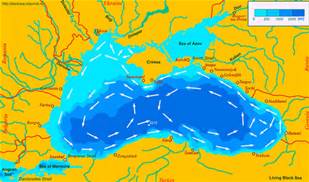
Black Sea Currents
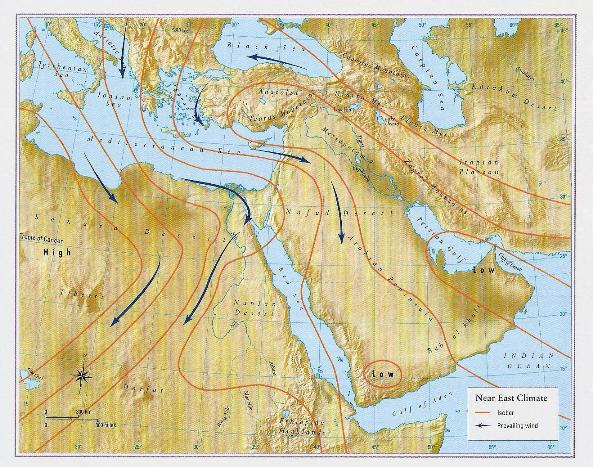
Prevailing Winds over the
Black Sea - the Sea of Marmara - the Aegean Sea and the Eastern Mediterranean. (The HISTORICAL ATLAS of JUDAISM,
pg. 13)
By oar if not always by sail, the forerunner barges of
the Yeredim could have progressed westward towards the Pillars of Hercules. At some point, they left behind their
preparatory craft on a western Mediterranean shore.
They were smitten because of their iniquities and were
driven forth. They journeyed across wilderness to the tempestuous Atlantic
coast.
(Ether 3:3) There they beheld “that great sea which divideth the
lands.”
(Ether 2:13) The description likely refers not only to unseen
continents beyond the horizon, but to the blatant fact that the Atlantic
near its narrow merger with the Mediterranean, truly “divideth the lands” (Africa, Tarshish etc.) in the eyes of those who are there.
Four years the Yeredim dwelt
in tents in the wilderness upon the Atlantic side of the
Pillars of Hercules.
(Ether 2:13) Scripture states that they had
been “many years … in the wilderness”. But, scripture does not say that they
had wandered many years in the wilderness or that they had traveled great
distances on foot! The LORD had smitten and driven them. They had traveled
by land from the Mediterranean
to the Atlantic coast. In the verse which reads, “...these many years we
have been in the wilderness” there is absolutely no justification for the
notion of a trek across Asia or a protracted march (with their baggage and
animals) to a southern sea in the direction opposite to which they had first
set out. The Yeredim came to “the lake country” of North America by way of
the North Atlantic.
Joseph Smith championed the conjecture of Josiah Priest
and noted explorer Alexander Von Humboldt in the “idea of their [certain
ancient peoples Joseph Smith affirms were Jaredites] coming immediately
from the region of the tower of Babel … These traveled till they came …
to be in the regions of the now United States … a country of much
water … on account of the vast number of lakes found there …. called the
lake country.”
(J. Priest, American Antiquities and Discoveries
in the West, “Traits of the Mosaic History found among the Azteca
Nations”, 1834 edition, pg. 202)
Joseph Smith agreed with the opinion put forth in
Priest’s work that descendents of ancient peoples from the Great Lakes
regions “called the lake country”, eventually migrated south to Mexico, propagating their Flood and Babel legends.
In a Times and Seasons editorial Joseph Smith
states “These accounts, then, precisely agree, one of which was found in
Ontario county N.
Y…” Joseph affirms that the Jaredites in fact “arrived” in the “lake
country of America … a land which is choice above all the land of the
earth … This it [the Book of Mormon] further speaks is the land of
America…” (See Joseph Smith’s editorial (signed
“ED.”) on a chapter from Priest’s American Antiquities, Times and
Seasons, June 15. 1842, Vol. 3, pp. 818-820)
It’s obvious, from a thoughtful reading of Ether 2:9-12,
that the “land of promise” to which the Yeredim were carried, is land now
occupied by the United States of America:
“And now, we can behold the decrees of God concerning
this land, that it is a land of promise; and whatsoever nation shall possess
it shall serve God, or they shall be swept off when the fulness of his wrath
shall come upon them. And the
fulness of his wrath cometh upon them when they are ripened in iniquity.
For behold, this is a land which is choice above all
other lands [Choice to who? Read 2 Nephi 10: 11-14,
19 for the answer. Mexico,
Central and South America do not qualify
because of the emperors, dictators, and tyrants that have set foot upon
these lands.]; wherefore he that doth possess it shall serve God or
shall be swept off; for it is the everlasting decree of God.
And it is not until the fulness of iniquity among the children of the
land, that they are swept off.
And this cometh unto you, O ye Gentiles
[even Goyim or Gentiles should be able to discern
what land is being discussed], that ye may know the decrees of
God—that ye may repent, and not continue in your iniquities until the
fulness come, that ye may not
bring down
[possible wordplay on the meaning of “Jared” or “Jaredite”] the
fulness of the wrath of God upon you as the inhabitants of the land have
hitherto done.
Behold, this is a choice land, and whatsoever nation
[nation is singular, unlike the Americas] shall possess it shall be
free from bondage, and from captivity, and
from all other nations [not even Canada
qualifies as free from all other nations] under heaven, if they will
but serve the God of the land ...” (Ether 2:9 - 12)
The Oceangoing Barges
“Thy righteousness is
like the great mountains; thy judgments are a great deep: O LORD,
thou preservest man and beast.”
(Psalm 36:6, KJV)
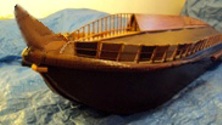
Baptiscaph - 8 ft model
made by V. Coon
Divinely led towards North America, the Yeredim crossed
wilderness and came to dwell in tents on the Atlantic side of the
Pillars of Hercules. After four years the LORD said to his
prophet chieftain Ahyered, “Go to work and build, after the manner of
barges which ye have hitherto built.”
So Ahyered went to work with his brethren, “and built barges
after the manner which they had built … And they were small, and they were
light upon the water, even like unto the lightness of a fowl upon the
water.”
(Ether 2:16)
Note that it was the forerunner or preparatory vessels
that were buoyant like fowl “upon the water”! The terms “small”, and
“lightness” are of course relative. Compared to the “ark of Noah”
(Ether 6:7) the barges of the Yeredim were very “small”. The word “lightness” in
this case refers not to weight but to buoyancy. The hulls of the forerunner
craft had a shallow draft. They did not sink appreciably in the water. In
the eyes of those who built them, the vessels may have even resembled
seabirds.
These light, open, humanly steered craft served in
bringing the Yeredim across “many waters” - i.e. from the Black Sea to a
wilderness shore of the western Mediterranean.
Did they simply abandon their light craft? Did they, like
the Apostle Paul encounter “a tempestuous wind”, an ancient “Euroclydon”
which grounded some of their semi-open barges?
(Acts 27:14) We only know
that the Yeredim came ashore again.
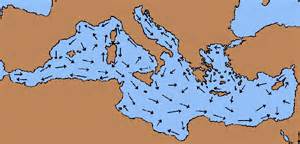
Main Currents of the Mediterranean
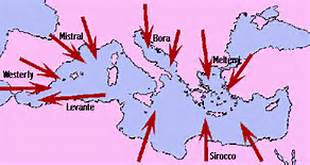
Main Winds of the
Mediterranean
Upon crossing a wilderness, the people came to face, not
another inland sea, but a “raging deep”.
(Ether 3:3) The forerunner craft,
like preparatory priesthood ordinances, had been designed to bring souls
only so far! The LORD did not intend the preparatory craft to carry his
people out into the stormy, ancient Atlantic.
At the LORD’s command the Yeredim began again to
construct hulls like those in which they had been initiated. But before long
the LORD gave his builders new - strange instructions, augmenting, even
departing from previous designs.
The new hulls were “built after a manner that they were
exceedingly tight, even that they would hold water like unto a dish”.
Of course the bottom of each boat was watertight. What’s
surprising about that? It had already been noted that the craft could float
“upon the water”. What then is the book of Ether referring to when it labors
to tell us that “they would hold water like unto a dish”?
Is the scripture suggesting something more in stressing
that the new hull not only could but “would hold water like unto a
dish”? The scripture follows with particulars: “the bottom thereof was tight
like unto a dish; and the sides thereof were tight like unto a dish”.
Well of course the bottom and sides of a boat are
watertight; but what if the inner sides and bottom of these craft were
designed to hold a plenum of freshwater – what if that is precisely what the
scripture is telling us?
The barges could have been built with a hull within a
hull - like a submarine. The inner hull, in this case, would have held
freshwater - sufficient for a long ocean voyage. An inner hull containing
freshwater may explain why the watertight carapace or covering of the barge
is not mentioned immediately after the mention of the inner bottom and sides
of the hull. Yes, “the top thereof was tight like unto a dish” too, but the
watertight covering of each barge was not designed to hold freshwater.
(Ether 2:17) The barge covering or carapace would be frequently inundated.
The watertight deck could have been designed to dish and shed seawater
aft of the craft – aiding the vessel’s forward movement.
We read that the ends of the barges were “peaked”. The
description “peaked” may suggest not only tapered ends but ends that are
raised or upturned – snorkel like. A peaked end would thus be the last part
submerged by “mountain waves”.
(Ether 6:6) If the “peaked” prow bent upward
more than the tapered aft, the snorkeling bow, may have also acted like a
weather vane, helping to direct the vessel parallel to the wind and
providing some forward propulsion.
The LORD designed the barges to be oriented and propelled
by natural forces. Low in the water, the barges did not have a large wind
cross-section (at least not like a sailing ship). But the design and loading
of the hulls, allowed the wind to orient them. Thus the hulls may have been
designed to allow a combination of wind and wave-action to help move them
along.
We read that the “length thereof was the length of a
tree”.
(Ether 2:17) The reason the length of each barge is described in such
comparative terms is likely because the long beams of each barge frame were
literally constructed from continuous sturdy timbers, bent bow like from
stem to stern. No two barges had exactly the same length. The maximum length
of each long timber depended on the length of the tree it was hewn from.
Indeed, the “length of a tree” is relative, but then so is the biblical
“amah” or “cubit”.
It would not at all be surprising if some of the ratios
and proportions of the barges approximated the “golden ratio” (approximately
1.618). This “divine proportion” is the limit of the ratio of two
consecutive Fibonacci numbers of the sequence 0, 1, 1, 2, 3, 5, 8 … as the
numbers approach infinity. It is a ratio which has long been regarded as a
sort of divine, mathematical signature present in the features of natural
things and approximated in the dimensions of Noah’s ark, the Ark of
the Covenant, and the Levitical altar etc. The oceangoing baptiscaphs
(immersion boats) of the Yeredim were designed by the same architect as “the ark of Noah”; having a
width to height ratio that is a Fibonacci approximation of the “divine
proportion”.
(Ether 6:7,
Genesis 6:15) It seems the LORD mathematically
signs his handiwork. (See
Golden ratio)

The
“golden ratio” or “divine proportion” occurs frequently in creation
As for the closing in of each barge, “the door thereof,
when it was shut, was tight like unto a dish.” Unlike the forerunner barges,
the fully covered oceangoing vessels of the Yeredim could be completely
sealed.
Is there not spiritual symbolism in all these physical
details?
(LDS Doctrine and Covenants 29:34)
When Ahyered had accomplished the strange, even
disturbing design modifications which the LORD had commanded, he cried “O
Lord, I have performed the work which thou hast commanded me, and I have
made the barges according as thou hast directed me. And behold, O Lord, in
them there is no light; whither shall we steer? And also we shall
perish, for in them we cannot breathe, save it is the air which is in
them; therefore we shall perish.”
Ahyered’s plea was (1) for visible light –
affording human sight to the practical end that they might control the
vessels by human hand, as they had previously done - that is, before they
faced such a “raging deep”! And (2) for that essential breath of life
that would allow them to carry on as mortals!
Having constructed the strange hermetic hulls, some must
have been curious enough to get inside and shut the door. They wanted to
find out how long they could endure in the tomb-like enclosure. This little
experiment made poignant a variety of aggravations and human necessities,
not just the need for air and sight. Of course there were many concerns, but
the need for breath was exigent! Had the LORD, who is Eternal, overlooked the
fact that they were mere mortals? Was their Promised Land to be the
netherworld? Did their past offenses warrant that they suffocate together in
darkness and filth before arriving at a watery Sheol?
Ahyered had presumed, that because they had
steered the forerunner barges across large inland waters, the Lord would
surely have them navigate “the great deep”. But this was not what the
Lord intended! The humbled company had reached the point that they would
have to completely give themselves into the hands of Adonai – “the Lord”.
Without him as their preparer and captain they had no hope of crossing the
“raging deep” alive to their covenant land.
(Ether 2:25)
To answer the need for air, the LORD directed, “thou
shalt make a hole in the top thereof,
and also in the bottom thereof; and
when thou shalt suffer for air thou shalt unstop the hole
thereof and receive air.
And if it be so that the water come in upon thee, behold, ye shall stop the
hole thereof, that ye may not perish in the
flood.”
(Ether 2:20, 1830 edition) The
repetitious “thereof” (removed from the
current edition) clearly refers to the hull of each barge - as in verse 17
of the current edition.
Thus reaching up and unstopping a hole in the top of each
hull would allow the occupants of the vessels to “receive air” (symbolic of
receiving the Spirit or breath of life –
רוּחַ). There was a
risk to this however: Because the ventilation hole was above them, water
could “come in upon” them, in which case they would have to quickly “stop
the hole” that they “perish not in the flood.”
Indeed, the “windows of heaven” can be overwhelming - but what if they
still needed air after stopping the hole?
An indirect means of supplying air to the interior of
each vessel may have been provided. Perhaps the Yeredim improvised something
like a skin bellows which connected to a system of stops (valves) that
communicated with the outside. It is also possible that the raised forward
end of each barge literally served as a kind of peaked snorkel. Perhaps the
prow was equipped with enclosed sinuses connected to check-valves (flaps),
so that vertical wave-action would pump air to the interior using the sea as
a piston. Thus the vessels may have been designed so that the interior could
be pressurized. Water invading the hull could then be driving out the hole
in the bottom by pumping air to the inside.
This brings us to the true purpose or purposes of the
bottom hole. Scripture is discrete and does not explicitly tell us what the
hole in the bottom was used for. But if readers will thoughtfully place
themselves in the sandals of the Yeredim, considering every needful thing,
the purpose for the hole in the bottom, I think, will become apparent.
Failure to do this has resulted in erroneous notions: For example:
the notion that the hole in the bottom was used for air in the event that
the barge capsized or was rolled upside down at sea. Good grief! Adonai
knows how to design a craft that will remain upright and stable even in
horrific seas! More on the hole in the hull bottom later.
The LORD instructed eight baptismal boats or barges to be
built.
(Ether 3:1) All total, the company of the Yeredim consisted of twenty
four families. That’s 22 in addition to the family of Yared, plus the family
of Ahyered.
(Ether 6:16) The Fibonacci number 8 happens to relate to
the scriptural subjects of baptism and the Flood.
(See 1 Peter 3:20-21) It’s
no coincidence that the number 24 is exactly divisible by 8. Each barge was
therefore large enough to accommodate 3 families, with “their flocks and
herds, and whatsoever beast or animal or fowl that they should carry
with them”.
(Ether 6:4)
Their stores likely included plenty of dried fish for
protein and honey for carbohydrate.
(See Ether 2:2-3) Though there is no
mention in scripture of the Jaredites bringing “bees” or vessels of live
“fish” with them across the “raging deep”, the fish and wondrous buzzing
thing helped prepare the Yeredim for enduring their own long entrapment.
Whatever the animals were that the Yeredim had on board, they certainly
didn’t pen elephants below in their “small” hulls (Mormon speculation to the
contrary).
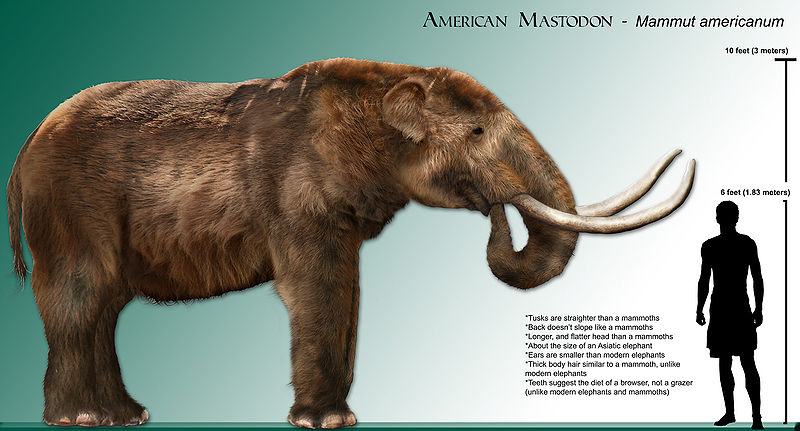
American Mastodon
It’s true that
dinotheres (elephant-like creatures) were indigenous to prehistoric New York, and “elephants” are mentioned in
Ether 9:19. But, had it been God’s design for the Yeredim to transport
elephants, he would have instructed them to build one big ark instead of
eight “small” barges!
(Ether 2:23) How then are we to account for the
ostensible presence of elephants in
America after the great deluge?
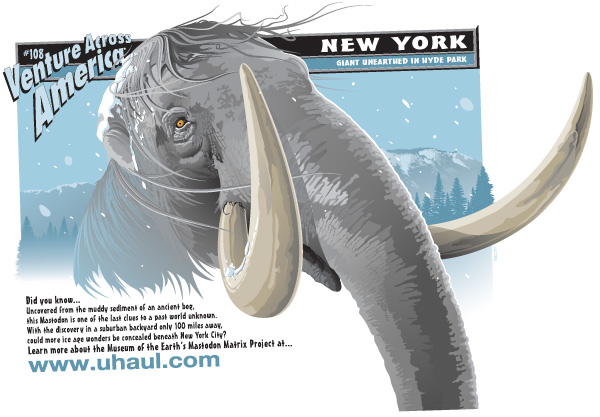
It’s a geological fact that western
New York
was long ago covered by water.
(Ether 13:2) It’s interesting that the book
of Moses mentions “the floods” – plural.
(Moses 7:43) Keep in mind that the
Hebrew expression translated “the whole earth” can simply mean the full
extent of a local land.
(Genesis 8:9) From the point of view of Noah
upon the waters, scanning a local horizon, there was no mountain top in
sight “under the whole heaven” – the ark clearing the baptized landscape
with a draft of about fifteen cubits.
(Genesis 7:19-20)
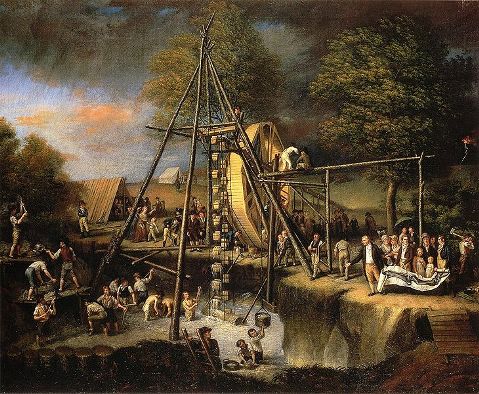
Exhuming an American Mastodon
Numerous remains of prehistoric megafauna and evidence
of their use by humans have been discovered in western New York. So many
mastodon remains have been found in western NY that it’s likely that former
inhabitants also unearthed the remains of at least one mastodon while
digging their extensive ditches.
(Alma 53:3) Similar finds have been made in the same general locale in modern
times - by ordinary people. (See
“New Mastodon Discovery in Western New York”)
Given all that the annotated book of Ether says about
“elephants” (which isn’t much), it’s entirely possible that certain Nephites
supposed that the New York
megafauna were contemporary with the Jaredites, whose records they had
found and translated. Unlike other animals listed in Ether 9:18-19,
elephants are mentioned nowhere else in the Book of Mormon!
Moroni is emphatic that in the American
Promised Land, the Jaredites “had horses, and asses”, “sheep” and
“goats” as well other kinds of animals. But unlike “horses” and “asses”
etc., Moroni doesn’t exactly say
that the Jaredites had elephants. Moroni more tactfully writes “and there
were elephants and cureloms and cumoms; all of which were useful unto
man…” Perhaps Moroni
kept in mind that it had only been the opinion of other Nephites that the
unearthed megafauna had lived at the same time as the ancient Yeredi
nation.
It’s
curious that the scripture says “the elephants and cureloms and cumoms” were especially “useful unto man”.
(Ether 9:19) Examples of the usefulness of mastodons to local prehistoric people
(predating the archaic Jaredites) can be seen at the Rochester Museum of
Science, western NY. The Nephites of old, like modern NY paleontologists, could have unearthed evidence of the usefulness of local prehistoric megafauna. The Nephites may have even had in their scriptures the Hebrew name for one
of the huge creatures whose bones they found - the creatures called “habim”
in the Old World. The substance “shen-habim”,
possibly meaning
“tooth of elephants”, is translated “ivory” in Gentile scripture.
(1 Kings 10:22,
2 Chronicles 9:21, KJV)
As for the presence in ancient New York of “horses” and
“asses”, isn’t it at least possible that limited numbers of these creatures
were brought to the region long ago by immigrants who tended them? Without
protection such domesticated animals would probably not have survived long
in a land where packs of wolves and other wild beasts roamed free.
(Alma 5:59) The Nephites happened to arrive in
the land when some of the vulnerable species (from one or more previous
migration and recently destroyed people) still survived on the loose.
(1 Nephi 18:25)
In time, without human protection, local domesticated animals would have
been decimated leaving little trace of their presence - a case in point for
Dr. Hugh Nibley’s observation that, “People underestimate the capacity of
things to disappear…” (An Approach to the Book
of Mormon, Appendix – The Archaeological Problem, pg. 431; See also “Ojibway spirit horses ...”,
“Ojibway horses are endangered...”,
“About the Breed”, and "The Relationship Between the Indigenous Peoples of the Americas and the Horse: Deconstructing a Eurocentric Myth")
Heavily loaded with freshwater, supplies, livestock,
human passengers and quite possibly stabilizing drogue stones (acting as sea
anchors. See
Anchor Stone) the oceangoing
barges sank low in the water. Their profiles and waterlines then became less
comparable to seafowl and more like that of surfaced whales. The decks rose
only slightly above water. For survival sake, the barges needed to be more
like turtles or cetaceans than wave tossed waterfowl.
(James 1:6) The LORD
had said “ye shall be as a whale in the midst of the sea; for the mountain
waves shall dash upon you. Nevertheless, I will bring you up again out of
the depths …”
(Ether 2:24)
So ocean waves tended to pass over the fully loaded
hulls! They “were many times buried in the depths of the sea…”
(Ether 6:6)
The ferocious, unrelenting commotion of the ancient Atlantic was such that had the vessels been lighter, and
without drogue stones hanging deep in the water, the occupants would have
been rolled and tossed to death! Because the barges sank deep, and were very
stable, tossing was minimized and made endurable. Yes, the slightly buoyant
craft were still “tossed upon the waves of the sea before the wind”, but not
to a perilous extreme.
(Ether 6:5)
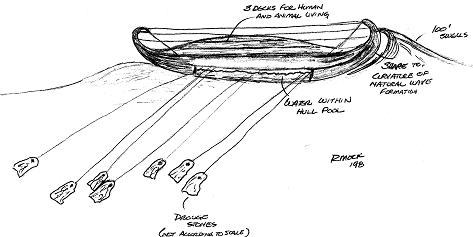
A
sketch of the ark with stabilizing drogue stones
(sea anchors)
Not navigated by human hand during the ocean voyage, the
eight Yeredi barges, with their precious cargo, must have been tied
together! Otherwise, they would become hopelessly separated at sea. They
needed to be bound to one another in order to arrive together. The vessels
also had to be equipped with some kind of external bumper or cushioning
protection, running the length of each barge. On occasion the tethered
barges would bump into each other. It may have been at these encounters that
parents assured their little ones that “no monster of the sea could break
them…”
(Ether 6:10)
Long cushioning bundles attached to the sides of the
barges may have terminated in something like sea-brooms. The flexing brooms
would resist and dampen the up and down forces acting on each craft,
converting part of the wave-action into forward motion. The ups and downs
needed to be resisted, not only so the passengers could survive the “dash”
of “mountain waves”, but so they could regularly hold down nourishment.
To minimize bumping, the barges on the outside of the
tethered flotilla may have featured angled fins or vanes which gave the
craft a tendency to slightly diverge from each other; while the wind and sea
anchors kept the craft more or less oriented in the same direction. The
string of tethered barges would therefore tend to separate rather than
converge together. In other words, a little opposition would have taken up
the slack in the tether lines, keeping the vessels bound but separate.
(2 Nephi 2:11)
The LORD caused “a furious wind” to blow, one which “did
never cease to blow towards the promised land while they were upon the
waters”.
(Ether 6:5,
8) Though “they were driven before the wind”
(Ether 6:8) it is important to keep in mind that the oceangoing vessels of the
Yeredim were not sailboats! It was not the lot of the Yeredim to navigate
there way to the Promise
Land as would Lehi’s
fractious company centuries later. The Yeredim had no brass instrument to
steer by, and no “windows”.
(Ether 2:23) Even so, they were united in songs
of ceaseless thanks and praise during their ocean ordeal.
(Ether 6:9) Of
necessity they had surrendered themselves to their guide and captain Adonai
Elohim; out of whose mouth the winds had gone forth and who had sent the
rains and the floods.
(Ether 2:24) He alone could bring them safely ashore
again, together and to the right place!
Stopping along the way for water and supplies was not an
option for the Yeredim. On occasion they might have procured a little
rainwater from the deck, but this would not have been a regular occurrence! The Yeredim had to stow in their compact hulls a year’s supply of everything
they needed: water, food, tools and medicine for each family and the living
things that depended on them.
With the hole in the top of the vessel stopped, the hole in the bottom could
be safely opened to admit a limited “m’qor” or dug out “fountain” of
seawater. (Psalm
36:9) The hole in the bottom was no doubt larger than the topside
ventilation hole. Such openings in boat bottoms today are called
moon pools .
Through the moon pool, human and animal waste could be
discharged from the vessel. The barges of the Yeredim were therefore truly
like cetaceans. The divine statement, “ye shall be as a whale in the midst
of the sea” came true in more than one way: Besides a hole on the top for
breathing and a hole on the bottom for discharging waste, imagine also the
dampening bundles fastened to the barge sides, fanning out like brooms at
the stern. These bumpering bundles would act as effectual tail fins offering
vertical resistance and gentle propulsion. The flexing brooms didn’t have to
be mechanically driven. Wave action caused angling and flexing and thrust.
Phyllis Olive has suggested that cork trees found
in the western Mediterranean regions could have provided a kind of
substitute blubber or buoyant, protective lining. Attached on the inside and
outside of the hull surfaces, a cork lining might have helped to insulate
and absorb shock. Cork
was not needed to help make the vessels buoyant. The ocean-going hulls
displaced so much water that the challenge was getting them to sink further.
The raging surface may not have been the sole source of oxygen
onboard. Fish take in the oxygen dissolved in water. The undulating waters
of the purifying moon pool, to a lesser extent, may have served to exchange
toxic carbon dioxide for breathable air. A portion of the carbon dioxide
from human and animal exhalation would dissolve in the waters of the
moon pool. Some vivifying oxygen would rise out of solution from the
convective seawater.
Scattered light from the sun or the moon above would
flicker through the moon pool below. The Yeredim could tell when a day had
passed.
(Ether 6:9,
11) When more air was needed the moon pool would be
closed - then the breathing hole in the top of the hull could be safely
opened if the deck was not awash. As a second option, the peaked snorkel,
with its wave pumped sinuses and check-valves (small built-in flaps) could
be opened for fresh air.
As solid food and freshwater were consumed onboard, and
waste discharged into the deep, the water-level of the “m’qor” or moon pool
would tend to change. With the hole in the bottom open, the water-level
inside the barge would also change in response to changes in hydrostatic
pressure, as when the barge rose from an inundation, or sank beneath a wave.
As previously described, fresh air could have been pumped
inside the craft in a controlled manner. With the hole in the bottom open,
the moon pool water level would be affected by the air pressure in the hull.
It may have been important to compensate for the volumes of waste that were
jettisoned. The moon pool water-level may have been deliberately controlled
and kept within its proper bounds.
(Proverbs 8:27,
Psalm 104:6-9)
Each day, refuse was discharged into the deep. Though
water did in fact pool inside their vessels, “there was no water that could
hurt them”
(Ether 6:7); the water inside being tightly confined by design.
Thus the moon pool fountain served primarily as a kind of ship’s head or
large cleansing font or toiled; but it may have served secondarily as a
means of buoyancy control. The hole in the bottom may even have facilitated
a little fishing while the surface raged on. Of course one had to be careful
what one caught!
Zoharim
“For with thee is
the fountain of life: in thy light shall we see light.”
(Psalm 36:9)
After fitting the barges with the necessary features for
air and hygiene, as Adonai had instructed, Ahyered once again pled
for light: “Behold, O Lord, will thou suffer that we shall cross this great
water in darkness?” The reply came: “What will ye that I should do that ye
may have light in your vessels?”
Now the Yeredim, like the apprentices of Tuval-qayin
(Genesis 4:22), had means of making fires hot enough to smelt metals. With
such heat they could melt sand (silica) or common quartz - making “glass”.
Clear quartz crystals can of course be found in mountains neighboring
the Gibraltar Strait.
It seems that Ahyered had considered the possibility of fusing quartz
into clear amorphous glass.
Perhaps he had experimented with making “transparent glass” for the
purpose of covering small portholes.
(Ether 3:1) But thick glass plates,
were they possible to make, would still have provided only meager light on
dark days, plunged in the “raging deep”; not to mention the night.
The Hebrew word “arubot” translated “windows” in
“windows of heaven”
(Genesis 7:11, KJV) suggests a gated structure -
lattice-like, something that can be opened and shut like a sluice. Such “windows”,
if not robustly designed, were prone to be
dashed open - becoming lethal flood gates.

Keel boat on the Erie
Canal – a type of covered boat (with windows) familiar to Joseph
Smith
The words “tsohar” [7]
and “halon” [8],
both translated “window” in connection with the ark of Noah,
do not clearly imply a glass covering.
(Genesis 6:16;
8:6, KJV)
A “tsohar”
(coming from a word meaning “shine”; as at noon) may simply be an opening
admitting light, perhaps a strongly covered opening. If the “halon” mentioned in
Genesis 8:6, which we
are told Noah made, is the same as the “tsohar” which he was
commanded to make
(Genesis 6:16), then the “tsohar” was just an opening
made in the ark.
Nevertheless, the footnote to Genesis 6:16 in the current
LDS edition of the King James Bible, directs the reader to the
rabbinical tradition of radiant gems or stones on board the ark.
(The Jerusalem Talmud, Pesahim 1:1, 5:2
cited by Hugh Nibley, THERE WERE JAREDITES, Ch. 3 notes 34, 37)
The apocryphal book of Jasher, on the other hand, interprets the Genesis “tsohar” to mean the ark’s “door, open at
its sides”. (Apocryphal Jasher V: 28)
The Greek Septuagint reads, “Thou shalt narrow the ark in making it, and in a cubit above thou shalt finish it, and the door of the ark thou shalt make on the side ...”
(LXX Genesis VI.17)
Was the ark then tapered at the ends? Moses’ reed ark of
Exodus 2:3 (using the same Egyptian loan word, "tevah", suggesting chest or coffin)
may have been bundled at the ends like a reed boat.
There is no clear answer as to what the “tsohar” of the ark was
referring to – perhaps
simply a narrow opening, perhaps with a removable roof covering.
(Genesis 8:13)
Even so, it would have been a blessing for Noah’s family to have possessed
zoharim
– multiple light sources.

Opening in the Ark
Portable zoharim would have been splendidly
helpful while caring for the animals below deck. One small opening in the
ark hardly seems adequate. There was definitely a need for multiple light
sources aboard the great vessel. What about candles or lamps? What - fire
aboard an enclosed vessel, sealed with what was likely a flammable substance
(pitch), on a rough sea? Out of the question.
Note: the verb and noun translated “pitch” in Genesis 6:14 comes from the root “kphr” (כּפר)
suggesting cover, atonement. May we likewise be brought
forth alive from the water.
How then was “light” to be provided in the barges of the
Yeredim? The LORD seemed to give only prohibitions: “ye cannot have windows,
for they will be dashed in pieces; neither shall ye take fire with you, for
ye shall not go by the light of fire.”
(Ether 2:23)
The sobering situation
was described in detail to Ahyered: They were to be utterly shut-in
below deck during the whole ocean voyage, as “a whale in the midst of the
sea” - “buried in the depths of the sea” beneath “mountain waves”; while
outside and above, a ceaseless “furious wind” and “great and terrible
tempests … caused by the fierceness of the wind” would drive them toward the
Promised Land.
Even so, and notwithstanding the meaning of “Yered” (go down, descend),
Adonai assured Ahyered and the Yeredim, “I will
bring you up again out of the depths of the sea”. Then the Eternal
rephrased the question: “Therefore what will ye that I should prepare for
you that ye may have light when ye are swallowed up in the depths of the
sea?”
Ahyered probably thought on how the need for light
was answered for his forefather Noah. However the idea came to him,
he started with what he knew and what he could reason out, and with
inspiration and follow-through brought his best physical attempt at reaching
a solution before Adonai: With
fire hot enough to melt metals, Ahyered “did molten out of a rock
sixteen small stones; and they were white and clear, even as transparent
glass” – but when at last his labor was done and the stones were cool to the
touch - they ceased to glow.
Dauntless, Ahyered carried the lifeless stones in
his hands to the top of har-Shelem and cried, “…I know, O Lord, that thou
hast all power, and can do whatsoever thou wilt for the benefit of man;
therefore touch these stones, O Lord, with thy finger, and prepare them
that they may shine forth in darkness; and they shall shine forth unto us in
the vessels which we have prepared, that we may have light while we shall
cross the sea. Behold, O Lord, thou canst do this.
We know that thou art able to show forth great power, which looks
small unto the understanding of men.”
(Ether 3:4-5)
And when Ahyered had said these words, Adonai
“stretched forth his hand and touched the stones one by one with his
finger.” And the veil was taken
from off the eyes of Ahyered, and he saw the finger of Adonai; and it
was as the finger of a man, and Ahyered “fell down
before the Lord, for he was struck with fear.” (Ether 3:6)
Now the question Adonai had put to Ahyered wasn’t
“what can I touch and make glow for you?” but rather “…what will ye that I
should prepare for you [you plural] that ye may have light …?”
(Ether 2:25) Adonai didn’t just touch the manmade glass objects presented to
him, he prepared them - meaning he did something to them. The Lord could
have placed elements in the heart of each stone that resulted in the
emission of visible light. These were not magical stones! They were common
fused quartz made by a man. Within them, removed from human contact,
surround by the clear protective glass that Ahyered had cast, Adonai
placed something like a powerful beta emitter, a source of mild but
sufficient radiation surrounded by a thin layer of an element like
phosphorous. These preparations would convert the energy of invisible
electron emissions in the heart of the stone, into visible photons shining
without. Incredibly, this type of self contained light source is possible
with today’s technology. (See
patent US4788437 and
Self-powered lighting)
And the Lord commanded Ahyered “to
go down out of the mount”
(Ether 4:1) “For it came to pass after the
Lord had prepared the stones which the brother of
Jared had
carried up into the mount, the brother of Jared
came down out
of the mount, and he did put forth the stones into the vessels which were
prepared, one in each end thereof; and behold, they did give light unto the
vessels. And thus the Lord caused stones to shine in darkness, to give light
unto men, women, and children, that they might not cross the great waters in
darkness.”
(Ether 6:2-3)
The Course of the LORD at
Sea
“…his paths are straight,
and his course is one eternal round”
(Alma 37:12)

Currents of the North
Atlantic Gyre
The Yeredi record (the book of Ether) tells us that “the
Lord God caused that there should be a furious wind blow upon the face of
the waters, towards the promised land…”
(Ether 6:5) and that “the
wind did never cease to blow towards the promised land while they
were upon the waters; and thus they were driven forth before the wind.”
(Ether 6:8)
But, scripture also informs us that “The wind goeth
toward the south, and turneth about unto the north; it whirleth about
continually, and the wind returneth again according to his circuits.”
(Ecclesiastes 1:6, KJV)
The prevailing winds and currents of the North Atlantic
Gyre move in a circuit continuously. We may see in this a natural analogue
to “the course of the Lord” being “one eternal round“.
(1 Nephi 10:19) One
would think that the winds and currents which drove the eight tethered
barges of the Yeredim naturally followed a circuitous path. When scripture
tells us that “the wind did never cease to blow towards the promised land…”
this doesn’t necessarily mean that the Jaredite barges traveled an
unnaturally direct course to the covenant land.
Nephi records that when his family “put forth into the
sea” from southern Arabia, that they “were
driven forth before the wind towards the promised land.”
(1 Nephi 18:8) From Arabia there is no direct course by sea, to the
Western Hemisphere! Some component of the wind always brought
them nearer their destination as they looked to God for direction.
Here in fact, is a likely meaning of the sacred directional instrument “Liahona
... interpreted, a compass”:
לְיהוֹעֵיני = “L’Yahoeynai” = “To the LORD
[Jehovah] my eyes”, or as the Book of Mormon simply phrases it: “look
to God”.
(Alma 37:38,
45-47) The Hebrew name is similar in spelling and meaning to one found in
1 Chronicles 3:23-24, where the name
אֶלְיוֹעֵינַי
is
translated “Elionai” (KJV).
If the Yeredim set forth into the North Atlantic near the
Pillars of Hercules, how long would it have taken them to arrive at the
Gulf of St. Lawrence? The St. Lawrence channel communicates with
“the lake country of America” - where
Joseph Smith said the Jaredites finally arrived? (See
Joseph Smith’s editorial (signed “ED.”) on a chapter from Priest’s
American Antiquities, Times and Seasons, June 15. 1842, Vol. 3,
pp. 818-820)
Keep in mind that the oceangoing Jaredite baptiscaphs
were best described as “barges”. By design they were slow moving, incredible
stable vessels on and below the surface. Though it is accurate to say that
the barges were “driven forth before the wind” they were in fact driven by
wind driven currents, and quite possibly also by transverse wave-action.
It’s true that the divinely designed sailing ship that
carried Lehi’s company (along their more out-of-the-way sea path) was
capable of greater speed than the tethered barges of the Yeredim. The
baptiscaphs, like the ark of Noah, sacrificed speed for stability;
and to that end they likely dragged massive drogue stones behind them in the
deep. The barges therefore must have exhibited considerable drag. They were,
after all designed to be barges and not clipper ships. Drag and drogue
stones would not only help keep them directed and stable, but would also
keep them from blindly crashing into shallow, rocky coasts.
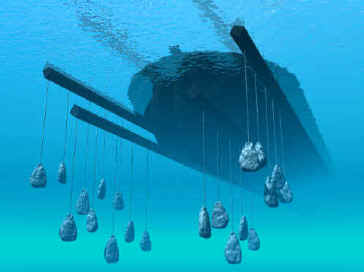
Drogue stones aft
It’s possible that the barges moved entirely under
natural influences for ~7,260 miles along an arc of the North Atlantic Gyre.
Oceanic surface currents are stirred mainly by the
prevailing winds. The speed of the Canary Current, along the western coast
of Africa, is from .2 to .7 mph. The North
Equatorial current slowly moves at a rate of about .2 to .35 mph. We may
regard the northwest Antilles Current as a continuation of the North
Equatorial Current. I estimate the weighted average speed of the Canary and
North Equatorial Currents to be about .35 mph.
We may estimate the average speed of the northward
sweeping Gulf Stream and North Atlantic
Current, along the Atlantic Coast of America, to have been between 1 to 6
knots, or about 3.453 miles per hour (~ 3.5 mph). That’s an order of
magnitude faster than the Canary and Equatorial currents. Swept by wind and
current it may have taken the barges about 24 days to traverse 1,980 miles
from a point a ways off the coast of Florida
to the Gulf of St. Lawrence.
How long would it take today to drift near
Florida from a launch site near the
Pillars of Hercules?
If you were a message in a bottle, drifting at a rate of
.35 mph it could take more than 628 days to reach the Florida Gulf Stream
from the a Spanish or Moroccan coast.
But scripture indicates that the ancient prevailing winds
were fierce!
Saint Brendan’s intrepid crew would probably have perished in
their skin covered boat had they tried to cross such a raging sea as lay
before Ahyered. Keep in mind that the slow moving Yeredi barges were
driven to some extent by “furious wind” acting on their snorkeling prows and
decks – as well as by wave-action.
The barges could have progressed from their launch near
the Pillars of Hercules to the waters of the Bahamas at an average speed of about 5.280 miles
/ 320 days = 16.5 miles per day (.7 mph) before they were swept northward by
the Gulf Stream. A speed of .7 mph along a southward to westward arc of the
North Atlantic Gyre (via the Canary and North Equatorial Currents) is
reasonable, given the nature of the craft and their likely means of
propulsion. The top speed of today’s Canary Current happens to be about .7
mph.
The total average speed of the barges along the arc of
the North Atlantic Gyre (from coasts near the Strait of Gibraltar
to the Gulf of St. Lawrence)
works out to be a believable 7260 miles / 344 days = 21.1 miles per day, or
just under a mile an hour. In other words, the scriptural 344 day ocean
crossing
(Ether 6:11) reasonably fits a voyage in the ancient
North Atlantic.
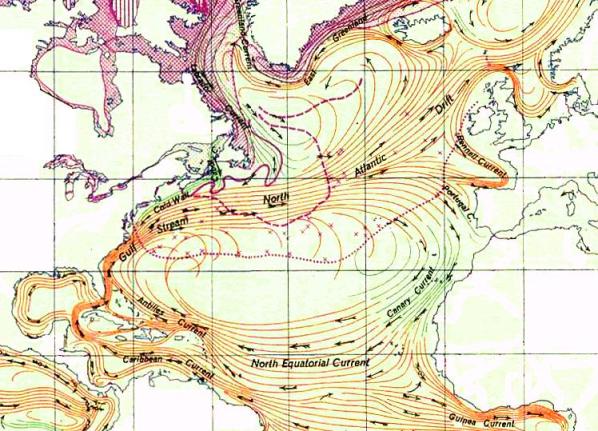
The Jaredite baptiscaphs
(immersion boats)
moved with the prevailing winds and currents of the North Atlantic “towards the promised land”.
Hurled by the Gulf Stream northward, the Jaredites were
carried to shores of the Promised Land in the general vicinity of the
Gulf of St. Lawrence. The “fierceness of the wind” had abated. A
great deal of weight had been discharged (over the course of the voyage)
from the bottom of each barge. Though their stores of food and freshwater
were greatly diminished, they were now near promised shores.
Their drogue stones dragging on the seafloor prevented
their crashing into rocks close to shore. Having arrived at coasts of
North America, they could now cut the lines to their heaviest
sea anchors, lightening their un-tethered craft considerably. They had
crossed the “great deep” like a pod of whales. Now with their hulls
unburdened off the shore of the Promised Land, they became buoyant and
unfettered as “fowl upon the water.”
(Ether 2:16,
24)
They could “steer” their vessels now. Crews could go
topside to row, or to sail up the freshwater St. Lawrence to the “lake
country of America”;
where Joseph Smith said they finally arrived. (See
Joseph Smith’s editorial (signed “ED.”) on a chapter from Priest’s
American Antiquities, Times and Seasons, June 15. 1842, Vol. 3,
pp. 818-820) This would not have been the first time they had
navigated a strait.
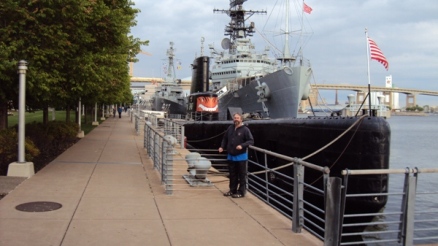
Refitted WWII Submarine U.S.S. Croaker
moored in the mouth of Buffalo River. This river flows into the Book of Mormon
“west sea” (Lake Erie). The submarine came
up the St. Lawrence Channel from the Atlantic Ocean to Lake
Ontario
(the Book of Mormon’s
“waters of Ripliancum”). The vessel thus traversed a route similar to
that of the Jaredites, who settled along the southern coast of Lake Ontario
(Ancient Lake Iroquois)
– in the land Joseph Smith referred to as “the lake country of America”. After crossing Lake
Ontario, the U.S.S. Croaker was towed through Canadian locks, and across
Lake Erie to its present mooring at the mouth of the Book of Mormon
“river Sidon” (Buffalo River).
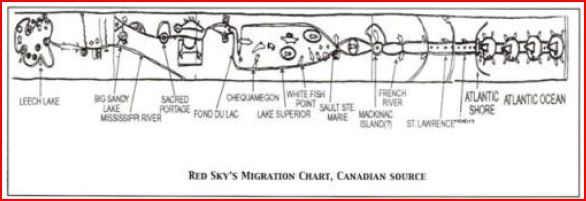
Ancient peoples arrived at the “lake
country of America” by way
of the St. Lawrence Channel.
(Wayne May, THIS LAND - They Came from the EAST, pg 220)
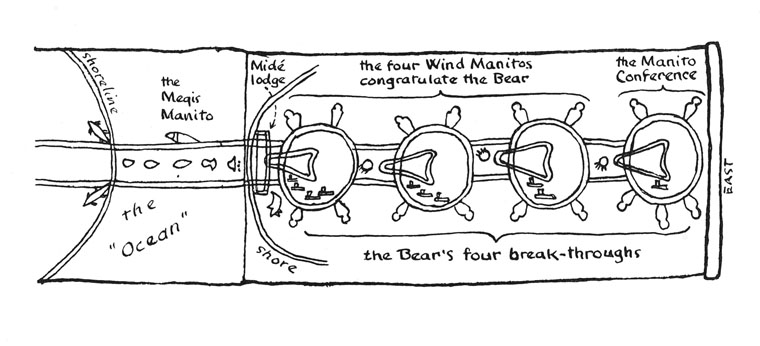
“... the Lord God would send or bring forth another people to possess the land, by his power, after the manner by which he brought their [Yeredi] fathers.”
(Ether 11:21)
According to Algonquin
tradition; their ancestors long ago crossed the “great water” (the Atlantic Ocean). They came from “the land of
the rising sun”. Their boats entered the St. Lawrence Channel and landed on
the shores of “Turtle Island” (North America) in the vicinity of the Great Lakes. In Red Sky’s Migration chart above, notice
the channel on the east and the representation of the
Atlantic Ocean.
It is worth considering that the original homeland of the
Yeredim (near the Black Sea) was in certain respects comparable to the
American homeland they arrived at (near
Lake Iroquois, called “Ripliancum”
in Ether 15:8, now called Lake Ontario). Both lands situated on the southern
shore of a large inland sea at about the same latitude and elevation. Both
inland seas communicated with the Ocean via channel(s). We should also
consider that anciently, Ripliancum connected with the Atlantic via the
Mohawk and
Hudon River.
Similarly, the American Promised Land to which Lehi’s
company was led (via a more southern route) is analogues to the
land of Israel they departed. Both lands have a
large inland sea on the west and smaller inland seas on the east.
In Conclusion: The ocean voyage of the Yeredim was
not navigated by them! They did not sail to America
as Lehi’s company did. Though slower going at sea, the Yeredim were carried
a more direct way to
America
in contrast to the voyage of Lehi’s contentious company. The company of
Yared and Ahyered “set forth into the sea, commending themselves unto
the Lord their God.”
(Ether 6:4) Like Lehi’s party, the Jaredites made more
than one landing on North American shores as they crossed “the large waters
into the promised land”.
(1 Nephi summary) “And when they [the Yeredim] had set their feet upon the shores [plural] of the
promised land” the
Yeredim
“bowed themselves down upon the
face the land… and did shed tears of joy before the Lord, because of the
multitude of his tender mercies over them.”
(Ether 6:12)
| 











